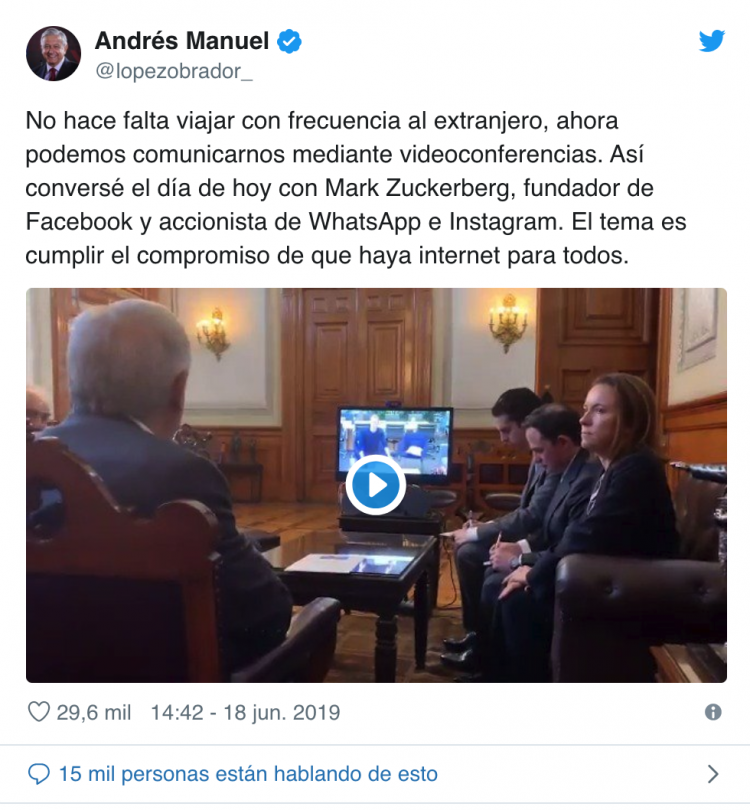
MDC Newsroom
The electrical networks of the Federal Electricity Commission (CFE, by its acronym in Spanish) will be the conduit for the fiber optic that is intended to cover 95% of the Mexican population on the Internet.
On August 2nd, 2019 Mexico announced the creation of CFE Telecommunications, a new internet service provider managed by Mexico’s federal government with the mission to provide internet for everyone. The federal government will repurpose 50 thousand kilometers of fiber optic cable that served as the backbone of the country’s National Network of Fiber Optics. This new entity will have its own legal body and assets. CFE plans to start activities in 2020, but the exact day and operational detail of the project have not yet been published.
“It is a subsidiary of the CFE, why? Because the entire infrastructure of the CFE is going to be used, there is fiber optic to communicate the country over the internet. It has already been approved by the CFE’s board of directors, and it is already requesting to have the concession and to be able to provide the non-profit service to all those who live in the most remote communities of the country. “
Andrés Manuel López Obrador, president of Mexico.
Back on August 14, 2019, the Ministry of Communications and Transportation (SCT) suspended the bidding process to create a centralized backbone network (Red Troncal), arguing that the project needs to be reconsidered to be consistent with the objectives of the National Development Plan of 2019-2024.
The bidding process to create a centralized backbone network was intended to facilitate access to a high-capacity fiber-optic network to boost a greater supply of reliable internet services nationwide at competitive prices and thus facilitate digital inclusion and the adoption of information technologies.
How will this new federal internet company work?
In one of his morning conferences, the president of Mexico Andrés Manuel López Obrador commented that the infrastructure of the CFE will be the starting point for the deployment of coverage to the network; which will be carried out through antennas, each one arranged in Service Integrating Centers, where the administration will offer a series of services.
It is planned that each of the Service Integration Centers will receive an internet signal, which will be repeated later to other locations. It is important to mention that there will be no antennas for all locations, the government has assured that an antenna will be enough to repeat the signal to the surrounding areas.
The creation of 10,000 Service Integrating Centers has been planned. But the estimated radius that can be covered with a single antenna has not yet been specified so that it can reach the surrounding communities without complications.
The president of Mexico wants Facebook as an ally
In June 2019, President Andrés Manuel López Obrador talked about this project with Mark Zuckerberg, CEO of Facebook and invited him to participate in this initiative.
“If you consider it interesting, we invite you to participate to be able to make a society. It would be something extraordinary that Facebook will help in communication, in the connectivity of Mexico”
said the president through the video call made from the National Palace.
So far, the response of the Big Tech leader is unknown, however, the action envisages the government’s openness to collaborate with international companies.
The telecom industry in Mexico is optimistic
Despite the little information available so far, companies interested in bidding for the Backbone Network, for now, canceled, believe that this new way of dealing with the country’s connectivity project does not close the opportunities for operators to make a deal.
In an interview published the Economist José Luis Peralta, advisor of the Plan-A, who was interested at the time by the Red Trunk commented:
“There is a clearer definition of what the project is and that is positive. We will remain interested because we will have to see what opportunities there are to participate. While there is no longer a network to build that way, this process must be helped. We still believe that the CFE Telecommunications project, if complemented, can generate interesting dynamics with the concessionaires. Until you know the definition well, it is difficult to say whether the CFE Telecommunications Internet for All plan is positive or negative. ”






